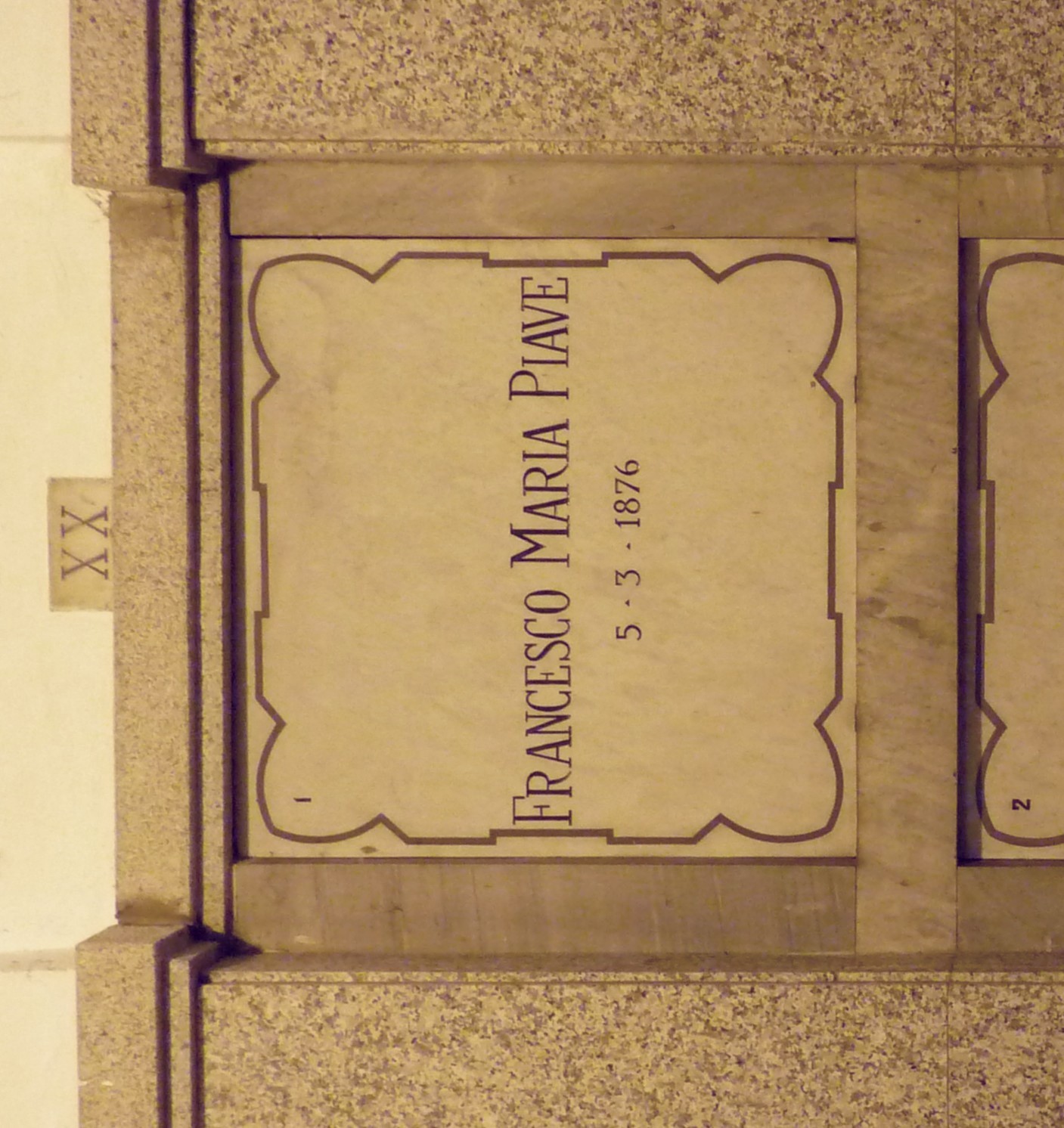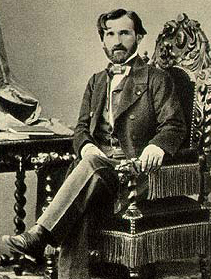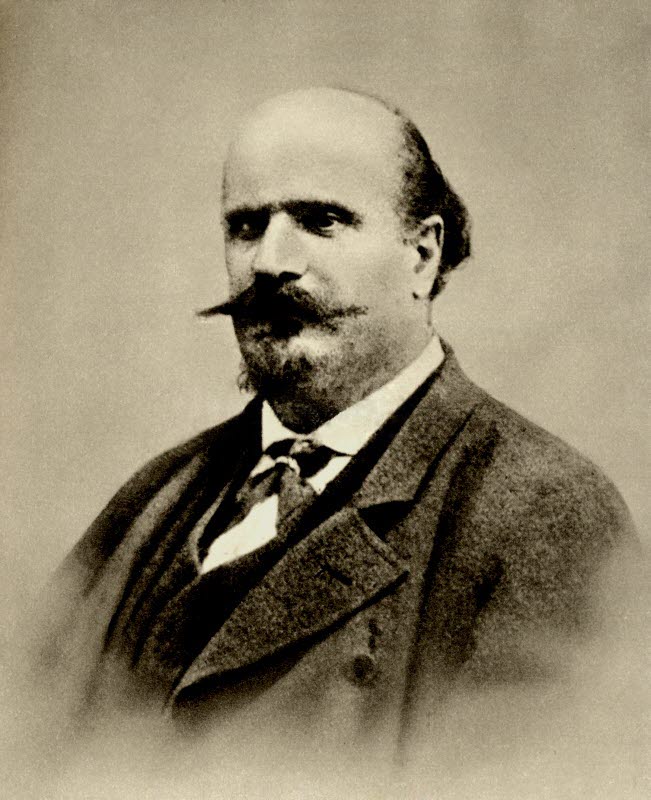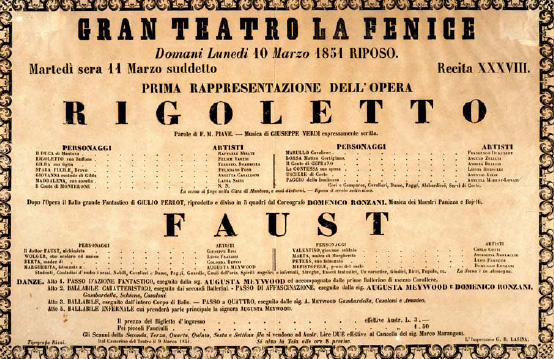|
Francesco Maria Piave
Francesco Maria Piave (18 May 18105 March 1876) was an Italian opera librettist who was born in Murano in the lagoon of Venice, during the brief Napoleonic Kingdom of Italy. Career Piave's career spanned over twenty years working with many of the significant composers of his day, including Giovanni Pacini (four librettos), Saverio Mercadante (at least one), Federico Ricci, and even one for Michael Balfe. He is most well known as Giuseppe Verdi's librettist, for whom he was to write 10 librettos, the most well-known being those for ''Rigoletto'' and ''La traviata''. But Piave was not only a librettist: he was a journalist and translator in addition to being the resident poet and stage manager at La Fenice in Venice where he first encountered Verdi. Later, Verdi was helpful in securing him the same position at La Scala in Milan.Baldini 1970, pp. 70 - 74 His expertise as a stage manager and his tact as a negotiator served Verdi very well, but the composer bullied him mercilessly ... [...More Info...] [...Related Items...] OR: [Wikipedia] [Google] [Baidu] |
Aroldo
''Aroldo'' () is an opera in four acts by Giuseppe Verdi to an Italian libretto by Francesco Maria Piave, based on and adapted from their earlier 1850 collaboration, ''Stiffelio''. The first performance was given in the Teatro Nuovo Comunale in Rimini on 16 August 1857. Composition history ''Stiffelio'' had provoked the censorship board because of “the immoral and rough” storylines of a Protestant minister deceived by his wife and also because making the characters German did not please an Italian audience, although, as Budden notes, the opera "enjoyed a limited circulation (in Italy), but with the title changed to ''Guglielmo Wellingrode'', the main protagonist now a German minister of state".Budden 2001, p.13 Verdi had rejected an 1852 request to write a new last act for the ''Wellingrode'' version, but, by Spring 1856, in collaboration with his original librettist, Piave, he decided to rewrite the story line and make a small number of musical changes and additions.Verdi to De ... [...More Info...] [...Related Items...] OR: [Wikipedia] [Google] [Baidu] |
Stiffelio
''Stiffelio'' is an opera in three acts by Giuseppe Verdi, from an Italian libretto by Francesco Maria Piave. The origin of this was the novel ''Le pasteur d’hommes'', by Émile Souvestre, which was published in 1838. This was adapted into the French play ''Le pasteur, ou L'évangile et le foyer'' by Souvestre together with Eugène Bourgeois. (Its premiere was on 10 February 1849 at the Théâtre de la Porte Saint-Martin in Paris.) That play was in turn translated into Italian by Gaetano Vestri as ''Stifellius''; this formed the basis of Piave's libretto. Verdi's experience in Naples for ''Luisa Miller'' had not been a good one and he returned home to Busseto to consider the subject for his next opera. The idea for ''Stiffelio'' came from his librettist and, entering into a contract with his publisher, Ricordi, he agreed to proceed, leaving the decision as to the location of the premiere to Ricordi. This became the Teatro Grande (now the Teatro Comunale Giuseppe Verdi) in Triest ... [...More Info...] [...Related Items...] OR: [Wikipedia] [Google] [Baidu] |
Ernani
''Ernani'' is an operatic ''dramma lirico'' in four acts by Giuseppe Verdi to an Italian libretto by Francesco Maria Piave, based on the 1830 play ''Hernani (drama), Hernani'' by Victor Hugo. Verdi was commissioned by the Teatro La Fenice in Venice to write an opera, but finding the right subject took some time, and the composer worked with the inexperienced Piave in shaping first one and then another drama by Hugo into an acceptable libretto. As musicologist Roger Parker notes, the composer "intervened on several important points, insisting for example that the role of Ernani be sung by a tenor (rather than by a contralto as had originally been planned).Parker, p. 71 ''Ernani'' was first performed on 9 March 1844 and it was "immensely popular, and was revived countless times during its early years". It became Verdi's most popular opera until it was superseded by ''Il trovatore'' after 1853. In 1904 it became the first opera to be recorded completely. Composition history Fol ... [...More Info...] [...Related Items...] OR: [Wikipedia] [Google] [Baidu] |
Simon Boccanegra
''Simon Boccanegra'' () is an opera with a prologue and three acts by Giuseppe Verdi to an Italian libretto by Francesco Maria Piave, based on the play ''Simón Bocanegra'' (1843) by Antonio García Gutiérrez, whose play ''El trovador'' had been the basis for Verdi's 1853 opera, ''Il trovatore''. ''Simon Boccanegra'' was first performed at Teatro La Fenice in Venice on 12 March 1857. Given the complications of the original plot and the generally poor popular response – although the critical one was more encouraging – the opera dropped out of favour after 1866. Finally, 23 years later, Verdi's publisher persuaded the composer to revise the opera, with text changes to be prepared by Arrigo Boito, the librettist who aspired to work with the aging composer on a project which eventually became a new opera, ''Otello'', but to which Verdi had not totally committed at that time. The revised version of ''Simon Boccanegra'', with the now-famous Council Chamber scene, was first perfor ... [...More Info...] [...Related Items...] OR: [Wikipedia] [Google] [Baidu] |
La Traviata
''La traviata'' (; ''The Fallen Woman'') is an opera in three acts by Giuseppe Verdi set to an Italian libretto by Francesco Maria Piave. It is based on ''La Dame aux camélias'' (1852), a play by Alexandre Dumas ''fils'' adapted from his own 1848 novel. The opera was originally titled ''Violetta'', after the main character. It was first performed on 6 March 1853 at La Fenice opera house in Venice. Piave and Verdi wanted to follow Dumas in giving the opera a contemporary setting, but the authorities at La Fenice insisted that it be set in the past, "c. 1700". It was not until the 1880s that the composer's and librettist's original wishes were carried out and " realistic" productions were staged. ''La traviata'' has become immensely popular and is among the most frequently performed of all operas. Composition history For Verdi, the years 1851 to 1853 were filled with operatic activity. First, he had agreed with the librettist Salvadore Cammarano on a subject for what would ... [...More Info...] [...Related Items...] OR: [Wikipedia] [Google] [Baidu] |
Attila (opera)
''Attila'' is an opera in a prologue and three acts by Giuseppe Verdi to an Italian libretto by Temistocle Solera, based on the 1809 play ' (''Attila, King of the Huns'') by Zacharias Werner. The opera received its first performance at La Fenice in Venice on 17 March 1846. Ezio's act 2 aria of heroic resolution "" (My lot is cast, I am prepared for any warfare) is a fine example of a characteristic Verdian ''genre'', and it achieved fame in its own time with audiences in the context of the adoption of a liberal constitution by Ferdinand II.Stamatov, Peter, "Interpretive Activism and the Political Uses of Verdi's Operas in the 1840s" (June 2002). ''American Sociological Review'', 67 (3): pp. 345–366. Other contemporary comment praised the work as suitable for the "political education of the people", while, in contrast, others criticised the opera as "Teutonic" in nature. Composition history Verdi had read the ultra-Romantic play in April 1844, probably introduced to it by his fr ... [...More Info...] [...Related Items...] OR: [Wikipedia] [Google] [Baidu] |
Aida
''Aida'' (or ''Aïda'', ) is an opera in four acts by Giuseppe Verdi to an Italian libretto by Antonio Ghislanzoni. Set in the Old Kingdom of Egypt, it was commissioned by Cairo's Khedivial Opera House and had its première there on 24 December 1871, in a performance conducted by Giovanni Bottesini. Today the work holds a central place in the operatic canon, receiving performances every year around the world; at New York's Metropolitan Opera alone, ''Aida'' has been sung more than 1,100 times since 1886. Ghislanzoni's scheme follows a scenario often attributed to the French Egyptologist Auguste Mariette, but Verdi biographer Mary Jane Phillips-Matz argues that the source is actually Temistocle Solera. Elements of the opera's genesis and sources Isma'il Pasha, Khedive of Egypt, commissioned Verdi to write an opera to celebrate the opening of the Suez Canal, but Verdi declined. However, Auguste Mariette, a French Egyptologist, proposed to Khedive Pasha a plot for a celebratory ... [...More Info...] [...Related Items...] OR: [Wikipedia] [Google] [Baidu] |
Rigoletto (opera)
''Rigoletto'' is an opera in three acts by Giuseppe Verdi. The Italian libretto was written by Francesco Maria Piave based on the 1832 play ''Le roi s'amuse'' by Victor Hugo. Despite serious initial problems with the Austrian censors who had control over northern Italian theatres at the time, the opera had a triumphant premiere at La Fenice in Venice on 11 March 1851. The work, Verdi's sixteenth in the genre, is widely considered to be the first of the operatic masterpieces of Verdi's middle-to-late career. Its tragic story revolves around the licentious Duke of Mantua, his hunch-backed court jester Rigoletto, and Rigoletto's daughter Gilda. The opera's original title, ''La maledizione'' (The Curse), refers to a curse placed on both the Duke and Rigoletto by a courtier whose daughter the Duke has seduced with Rigoletto's encouragement. The curse comes to fruition when Gilda falls in love with the Duke and sacrifices her life to save him from the assassin hired by her father. Comp ... [...More Info...] [...Related Items...] OR: [Wikipedia] [Google] [Baidu] |
Il Corsaro
''Il corsaro'' (''The Corsair'') is an opera in three acts by Giuseppe Verdi, from a libretto by Francesco Maria Piave, based on Lord Byron's 1814 poem ''The Corsair''. The first performance was given at the Teatro Grande in Trieste on 25 October 1848. Composition history The composer expressed interest in Byron's poem ''The Corsair'' (along with ''The Two Foscari'' and others) as early as 1844 when he was planning an opera for Venice, but a suitable baritone was not available.Budden, pp. 363 – 366 In 1845, (before it was determined that ''I masnadieri'' was to be the opera presented in London), the composer had contracted with the Milanese publisher, Francesco Lucca, for three operas, including ''Attila'' and one for London. Three things prevented it from being ''I masnadieri'' at that time: firstly, Verdi's illness postponed any opera for London for almost a year; secondly, he demanded that the work be ''Il corsaro'' and that it be written by Piave, who had begun work; and, ... [...More Info...] [...Related Items...] OR: [Wikipedia] [Google] [Baidu] |
Macbeth (opera)
''Macbeth'' () is an opera in four acts by Giuseppe Verdi, with an Italian libretto by Francesco Maria Piave and additions by Andrea Maffei, based on William Shakespeare's play of the same name. Written for the Teatro della Pergola in Florence, it was Verdi's tenth opera and premiered on 14 March 1847. ''Macbeth'' was the first Shakespeare play that Verdi adapted for the operatic stage. Almost twenty years later, ''Macbeth'' was revised and expanded in a French version and given in Paris on 19 April 1865. After the success of ''Attila'' in 1846, by which time the composer had become well established, ''Macbeth'' came before the great successes of 1851 to 1853 (''Rigoletto'', ''Il trovatore'' and '' La traviata'') which propelled him into universal fame. As sources, Shakespeare's plays provided Verdi with lifelong inspiration: some, such as an adaption of ''King Lear'' (as ''Re Lear'') were never realized, but he wrote his two final operas using ''Othello'' as the basis for ' ... [...More Info...] [...Related Items...] OR: [Wikipedia] [Google] [Baidu] |
Salvadore Cammarano
Salvadore Cammarano (also Salvatore) (born Naples, 19 March 1801 – died Naples 17 July 1852) was a prolific Italian librettist and playwright perhaps best known for writing the text of ''Lucia di Lammermoor'' (1835) for Gaetano Donizetti. For Donizetti he also contributed the libretti for ''L'assedio di Calais'' (1836), ''Belisario'' (1836), ''Pia de' Tolomei'' (1837), ''Roberto Devereux'' (1837), ''Maria de Rudenz'' (1838), ''Poliuto'' (1838), and ''Maria di Rohan'' (1843), while for Giuseppe Persiani he was the author of ''Ines de Castro''. For Verdi he wrote ''Alzira'' (1845), ''La battaglia di Legnano'' (1849) and ''Luisa Miller'' (1849), but after he died in July 1852, Verdi worked with Leone Emanuele Bardare to complete the libretto for ''Il trovatore'' (1853).Budden, Vol. 2, p.65 Cammarano also started work on libretto for a proposed adaptation of William Shakespeare's play ''King Lear'', named ''Re Lear'', but he died before completing it; a detailed scenario survives ... [...More Info...] [...Related Items...] OR: [Wikipedia] [Google] [Baidu] |









.jpg)

